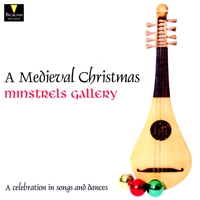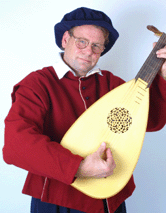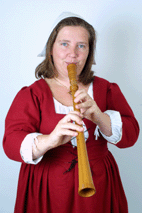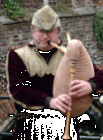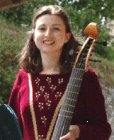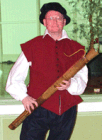A Medieval Christmas by Minstrels Gallery
A medieval winter was a cold, dark time and music played an important part in the the winter festive celebrations. When the Christian church "hijacked" the pagan winter festivities it brought into being a whole range of new music - some reflective and some out rightly joyous. Buy this album now CD: £9.99 + p&p |
| 1 | Lament Of Rachel |
Anon England 12C |
| 2 | Stella Splendens | Llibre Vermell Spain 14C |
| 3 | Gaudete | Jistebnice Cantional 1420 |
| 4 | Christ Ist Erstanden | Hans Judenkunig 1526 |
| 5 | Gavottes | Praetorius 1571-1621 |
| 6 | Jezis Nas Spasite | J Cancional 1420 |
| 7 | In Dulci Jubilo | Praetorius 1571-1621 |
| 8 | Sans Day Carol | Trad English |
| 9 | A Chantar | La Comtessa de Dia 14C |
| 10 | Quand Je Voi | Anon France 13C |
| 11 | Maravillosos | Cantigas de Santa Maria 13C |
| 12 | A Boy is Born | Praetorius 1571-1621 |
| 13 | Shepherds Hey | Trad England |
| 14 | Ronde | Tielman Susato 1551 |
| 15 | Beata Progenies | Leonel Power 15C |
| 16 | The Waits | Playford 17C |
| 17 | Sussex Carol | Trad England |
| 18 | Anni Novi Novitas | Eastern European 14C |
| 19 | Wassailing | Trad England |
| 20 | Basse Dance Magdalena | Attaingnant 1530 |
| 21 | Angelus Ad Virginem | Trad England 13C |
| 22 | Remember O Thou Man | Ravenscroft 17C |
| 23 | Branle De L'Official | Arbeau 1589 |
| 24 | This Ay Nicht | Anon England 13C |
| 25 | God Rest Ye | Trad England |
| 26 | Of All The Birds | Ravenscroft 17C |
| 27 | What Child In This | Anon England |
| 28 | Greensleeves All My Joy | Anon England |
| 29 | Coventry Carol | Anon England 13C |
| 30 | Polorum Regina | Llibre Vermell
Spain 14C |
Sleeve Notes A Medieval Christmas To us in the twenty-first century winter holds no fear, we may have to service the central heating or buy a new coat but otherwise life remains much as it is through the rest of the year. However, for our medieval ancestors the privations of winter presented a real threat to survival. With the onset of winter the next growing season seemed a very long way off. This long, cold, dark time needed to be defeated. Little wonder then that a great winter festival should have flourished to banish the hardships of the season. These winter celebrations far pre-date any Christian festival. The gods that brought the cold and darkness needed to be appeased, to assure the return of fertility to the land. A major element in this ancient pagan ritual was to bring light out of darkness and see off the old year whilst celebrating the coming of the new. Track 10 Quand Je Voi, Track 18 Anni Novi Novitas. By the fourth century AD The Church had imposed a Christian festival onto this winter pagan feast and a date, that of December 25th, was fixed on. Though The Church wanted to celebrate the birth of Christ it was ambiguous about the method of that celebration. Early Christians were warned against "feasting to excess, dancing and crowning the doors with evergreens”. As today, it seems that The Church had difficulty in getting the message of the nativity across to the people. During a time of general illiteracy this message was best conveyed through music, art and theatre. Musical plays such as The Play Of Herod dramatised The Christmas Story in such a way that at least the reasonably educated could understand. The play reaches its climax with the lament of Rachel over the slain children. Track 1 Lament Of Rachel, Track 15 Beata Progenies. The general populous also enjoyed their own form of theatre this time performed in the vernacular. Mummers plays dramatised the simpler themes of the triumph of good over evil or light over darkness and usually featured characters such as St George, the Turkish Knight, Robin Hood and the Green Man. Closely associated with the mummers was the custom of wassailing - where a wassail bowl, filled with a warmed mixture of ale, cider, spices, sugar, raisins and apples, would be passed around by village singers as they journeyed from door to door in search of alms. The ritual culminated in the pouring of the bowl’s contents over the roots of the apple trees to ensure a good harvest in the year to come. Track 19 Wassailing, Track 22 Remember O Thou Man. Whilst the general populous was celebrating with mumming and wassailing, medieval royalty used the Christmas season as a display of their great wealth. A feast hosted by King John in 1213 surpassed the most sumptuous of banquets. Whist his son Henry III, in 1252, entertained 1,000 knights and peers at York. The feast was so expensive that the Archbishop of York gave 600 fat oxen and a donation of £2,700. A century and a half later Richard II provided 2,000 oxen and 200 barrels of wine for the 10,000 people who dined at his expense. This was more than generosity; it was good politics, enhancing the reputation of the host at this otherwise bleak time of year. However, a much more frugal time was reported by Margaret Paston of Norfolk on Christmas Eve 1459. In a letter, she writes, "There was no disguising [acting], nor harping, luting or singing, nor any lewd sports, but just playing at the tables and chess and cards”. Track 16 The Waits, Track 26 Of All The Birds. A custom that may seem somewhat eccentric to us, was that of electing a "Boy Bishop” in cathedrals during the thirteenth Century. The selected boy would be appointed as bishop for the Christmas period and performed pseudo-episcopal duties which included everything except the delivering of the mass. This custom was finally abolished in 1559. A similar custom was that of the "Lord of Misrule”. His job was to direct and arrange all Christmas entertainments; masques, processions and feasts. This tradition was particularly prevalent at the Inns of Court and the universities of Cambridge and Oxford. Track 14 Ronde, Track 28 Greensleeves. During the thirteenth century, Spain and Portugal underwent a cult of the Virgin Mary, in fact more miracles were attributed to her than any other saint. Over four hundred songs were assembled at the court of King Alfonso The Wise of Castille and Lyon in a collection known as the Cantigas de Santa Maria. Track 11 Maravillosos. A similar collection of fewer songs is to be found in the Llibre Vermell or Red Book from Catalonia. Track 2 Stella Splendens, Track 30 Polorum Regina.
|
Credits Tony
Scheuregger: voice, cittem, crumhom, flute, gittem,
lute, mandora, percussion, rebec, recorder, vihuela. |
| Instruments: | Medieval Instruments |
| Genre: | Medieval Music |
| Format: | CD Rom |
| Our Ref: | A0183 |
| MCPS: | MG004 |
| Label: | BEACON |
| Year: | 2006 |
| Origin: | UK |
Minstrels Gallery were formed in 1997 by Tony Scheuregger to provide early music at weddings, dinners, parties and concerts. The group has developed an eclectic repertoire of music from the early medieval period through to the middle 17th century. The ensemble play throughout the United Kingdom performing at venues such as The British Museum, The Reform Club, The National Maritime Museum, Banqueting House, Leeds Castle and many other places of special historic interest. Tony and Jane provide concerts and workshops for schools and colleges and are currently working on an interactive CD-ROM for classroom use. The group have played live sets on BBC local
radio, and appeared on National BBC TV and Yorkshire TV News.
Minstrels Gallery came about as a result of Tony's earlier experiences playing at medieval banquets in the Suffolk town of Bungay. Way back in late 1975 Tony was part of a group called 'Quodling's Delight' playing mainly at medieval banquets and the occasional concert. After
a gap of many years Tony formed a new group with his wife Jane
calling itself Minstrels Gallery. The membership of the group
has varied over the years but has now settled to a core of Tony,
Jane and son Martin. Other players join the group from time to
time either to meet the requirements of two engagements on the
same day or where a larger ensemble is needed.
|
||||||||||||||||||||||||||||
Contact
Details |
Tony
Scheuregger Minstrels Gallery 43 Muriel Road Norwich, Norfolk England NR2 3NY |
|||||||||||||||||||||||||||
Telephone |
01603 454402 | |||||||||||||||||||||||||||
Mobile |
07798 521577 | |||||||||||||||||||||||||||
E-mail |
info@minstrelsgallery.com | |||||||||||||||||||||||||||
Artists
Web Site |
www.minstrelsgallery.com | |||||||||||||||||||||||||||
